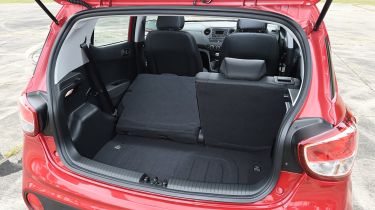Used Hyundai i10 (Mk2, 2014-2019) review - How practical is it?
Despite its dinky dimensions, the i10 is a surprisingly spacious and versatile small car
It’s a small car on the outside, but clever design and neat packaging means the i10 is more versatile than most rivals. The five-door layout boosts flexibility, while the smartly designed cabin will seat four adults in comfort. There’s also a decent-sized boot that rivals those in models from the class above for carrying capacity.
Dimensions and cabin design
The key to the i10’s interior space is right there in the spec list. At 1,500mm tall, it’s almost as high as it is wide, and that square space pays dividends both for interior room and for easy agility around town. This is a small car in which tall drivers can comfortably fit and out of which all drivers can comfortably see.
The front seats of the i10 pull off a neat trick. Usually in a small, tall car like this, extra space in the cabin is found by mounting the front seats tall and upright, and in some models this can make the driver feel as if they’re perched on rather than in their seat.
But that’s not the case in the Hyundai, which manages to provide a driving position that feels natural and comfortable. If you’re going to choose a small car for a long journey, it’s going to be this, a Volkswagen up! or a Skoda Citigo, at least in the comfort stakes.
Used - available now
That tall roof means headroom is simply not going to be a problem, and while knee room in the back isn’t exactly cavernous, you’ll be fine unless you’ve promised the local basketball team a lift.
Boot space
There’s a choice to make between space and space-saver when you’re buying a Hyundai i10. If you think you can do without the spare tyre in the boot, then the load bay has a capacity of up to 252 litres with the rear seats in place. That’s one of the biggest in the city car market, and as big as some cars in the next class up. Fold the back seats and the space expands to a small delivery van-like 1,046 litres.
However, if you specify a spare wheel in the showroom – or buy an i10 SE, which comes with the spare as standard – then boot space shrinks to a significantly less useful 218 litres. The maximum capacity is also reduced, although it’s still decent, at 1,012 litres.
Equipment and technology
Hyundai's infotainment system is fairly basic. A small LCD screen is flanked by hot keys and rotary dials that control the major functions, which include Bluetooth hands-free phone connection and wireless music streaming.
There’s also a USB port that allows you to charge your smartphone and play tunes stored on an external media device. Also included is DAB radio alongside the usual AM and FM functions, plus a single-slot CD player. All versions get four speakers, apart from the S, which has to make do with two.
Most of the unit’s features can be controlled via the multifunction steering wheel, including answering and ending phone calls. Better still, connecting your smartphone is fairly straightforward and the sound quality when used is good. If you want a more advanced set-up, then you’ll have to upgrade to the SE Premium, which gets a seven-inch touchscreen that includes sat-nav, Apple CarPlay and Android Auto.
Elsewhere, the i10’s dash is made of very high-grade materials, and the dials and instruments are just as upmarket. Plus, even the affordable, entry-level i10 S version comes with a decent level of equipment as standard. This includes electric front windows, an MP3-compatible stereo with USB and aux-in connections, as well as a full suite of electronic safety aids.
This SE spec brings air conditioning, body-coloured mirrors and door handles, a light in the boot and a height-adjustable driver's seat, as well as cruise control, electric rear windows and a space-saver tyre.
Premium and Premium SE models come loaded with kit to justify the extra outlay, and from 2016 features like a heated steering wheel are offered on the Premium SE.
While the standard i10 interior is a little drab, with lots of grey plastic on show, buyers can add blue or red interior trim at no extra cost to brighten up the interior.
Safety
One of the few things that lets the i10 down is its Euro NCAP safety score. The car was awarded four out of the maximum five stars when it was assessed as part of the independent programme. This was largely down to being marked down in the Safety Assist category, because the car doesn’t get all of the available electronic safety aids as standard.
That said, when new, Hyundai offered the i10 with an optional Driver Assist Pack, which features lane-departure and forward-collision assistance systems. It was available as an option on the SE, Premium and Premium SE models, so it’s worth checking whether any prospective purchase has this valuable addition.
On the plus side, there’s nothing wrong with the car’s body structure, as shown by its strong 79 per cent score for adult occupant protection, and 80 per cent result for child occupant protection.











